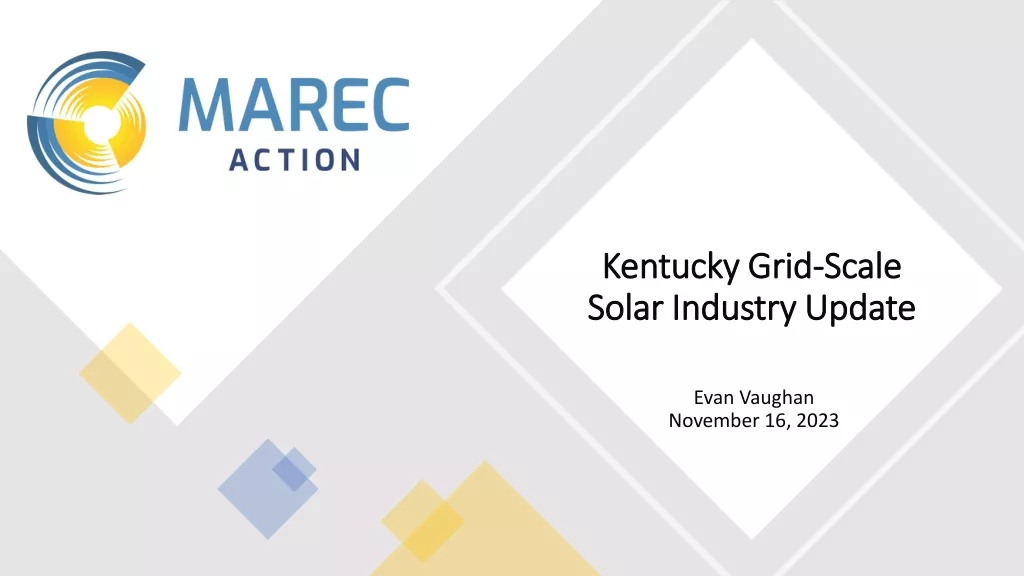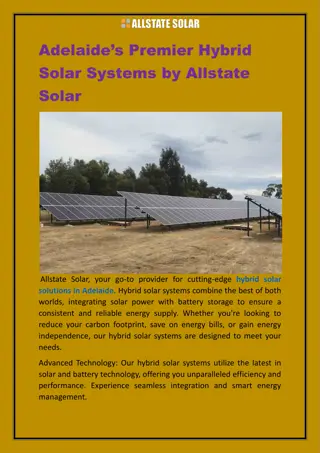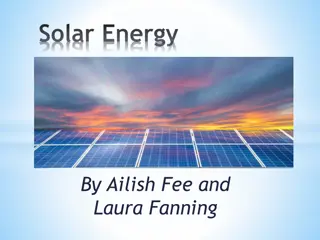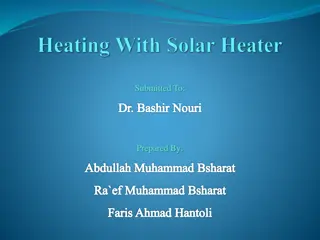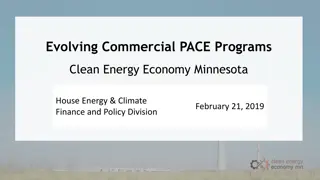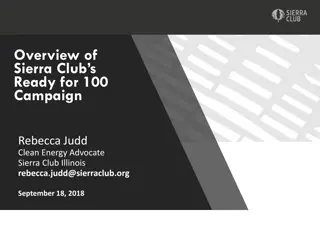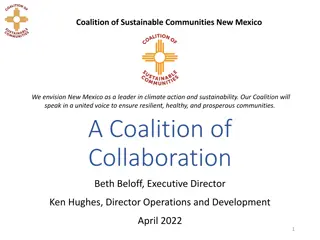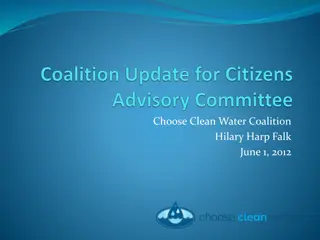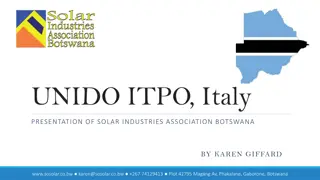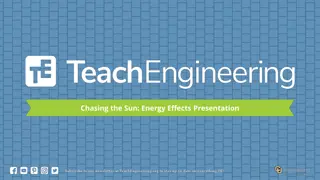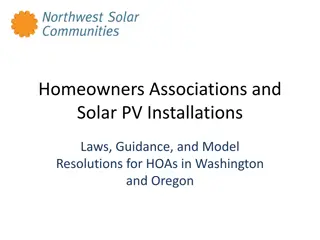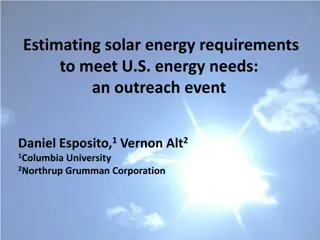Clean Coalition's Fixed Charge Proposal for Local Solar Energy
Clean Coalition, a nonprofit organization, aims to accelerate the transition to renewable energy with a proposed Fixed Charge solution that meets legal requirements and defends against attacks by utility companies. The solution, represented by Ben Schwartz and Josh Plaisted, focuses on clean local energy accessibility through policy expertise and technical development. It includes modest Fixed Charges that benefit low-income ratepayers while promoting resilience and reducing dependence on the transmission grid.
Download Presentation

Please find below an Image/Link to download the presentation.
The content on the website is provided AS IS for your information and personal use only. It may not be sold, licensed, or shared on other websites without obtaining consent from the author. Download presentation by click this link. If you encounter any issues during the download, it is possible that the publisher has removed the file from their server.
E N D
Presentation Transcript
A Fixed Charge solution that satisfies legal requirements while preempting another attack by the utilities on Local Solar Ben Schwartz Policy Manager Clean Coalition 626-232-7573 mobile ben@clean-coalition.org Josh Plaisted Principal Flagstaff Research 510-459-7970 mobile jplaisted@flagstaffresearch.com Making Clean Local Energy Accessible Now 15 August 2023
GoToWebinar FAQ Webinar recording and slides will be sent to registered attendees within two business days. All webinars are archived on clean- coalition.org, under Events. Submit questions in the Question pane at any time during the webinar. View varies by operating system and browser. Questions will be answered during the Q&A portion of the webinar. For other questions, contact Gregory Young Francescato: gregory@clean-coalition.org 2 Making Clean Local Energy Accessible Now
Clean Coalition (nonprofit) Mission To accelerate the transition to renewable energy and a modern grid through technical, policy, and project development expertise. 100% renewable energy end-game 25% local, interconnected within the distribution grid and facilitating resilience without dependence on the transmission grid. 75% remote, dependent on the transmission grid for serving loads. 3 Making Clean Local Energy Accessible Now
Presenters Ben Schwartz represents the Clean Coalition in proceedings at the CPUC, focusing on microgrids, interconnection, net energy metering, renewable procurement, rate design, and more. With a background in environmental studies and public policy, he brings valuable insight to the diverse local, state, and national policy work done at the Clean Coalition. Ben is passionate about helping humanity solve the three greatest crises that exist today: climate change, water scarcity, and the lack of clean energy. Ben holds a BA in History of Public Policy and Environmental Studies from UC Santa Barbara. Josh Plaisted received his MSME at UW Madison s Solar Energy Laboratory in tandem with a certificate in energy analysis and policy. He has over two decades experience in the solar field running product development, systems simulation, and field performance validation from startups to publicly traded multinational corporations. Mr. Plaisted has assisted in the development of regulatory standards and provided guidance and testimony before the CEC and CPUC. 4 Making Clean Local Energy Accessible Now
A Fixed Charge solution that satisfies legal requirements while preempting another attack by the utilities on Local Solar Ben Schwartz Policy Manager Clean Coalition 626-232-7573 mobile ben@clean-coalition.org Making Clean Local Energy Accessible Now 15 August 2023
The Clean Coalitions modest Fixed Charge proposal The Clean Coalition s proposed Fixed Charge is modest and will not burden any ratepayers. All low-income ratepayers will save money on their electricity bills each month. There are three tiers of Fixed Charges. Lower-income ratepayers will realize greater savings than non-low-income ratepayers. This proposal incorporates all the costs included in electricity that are truly fixed . Since rates are primarily collected on a volumetric basis ($/kWh) very few cost components are fixed. 6 Making Clean Local Energy Accessible Now
CPUC Proceeding (R. 22-07-005) Proceeding details: Track A is creating a residential Fixed Charge. Track B is aimed at transitioning rates to closer to real-time rates to unlock demand flexibility. The CPUC adopted Guiding Principles for Electric Rate Design and Demand Flexibility. Summary of other proposals: Most of the other Proposals were much higher and included four or more different tiers. 8 of 9 parties proposed Fixed Charges at, or above, $25 for non-CARE customers. 4 of 9 parties included at least 4 tiers, with one group proposing 10 tiers. Other proposals would be harder to implement (likely taking years). The Clean Coalition s proposal is both pragmatic and easy-to-implement, compared to other proposals that will require significant changes to the billing system and take years to implement. 7 Making Clean Local Energy Accessible Now
Methodology behind the Clean Coalitions proposal pt. 1 Covers the Marginal Customer Costs (e.g., the minimum bill for NEM customers). No transmission, generation, or public purpose charge components. Results in savings for low-income customers on day 1 and a decrease in overall rates. Three income tiers based on existing low-income subsidy programs. CARE: California Alternate Rates for Energy (30-35% bill credit) FERA: Family Electric Rate Assistance (18% bill credit) CARE customers do not pay any Fixed Charge. FERA customers, of whom there are fewer, still see a savings. All other customers pay as much or slightly more than they currently are. 8 Making Clean Local Energy Accessible Now
Methodology behind the Clean Coalitions proposal pt. 2 Redistributes the cost of existing minimum bills without increasing the total amount of money being collected from ratepayers. This is similar to the way CAISO collects Transmission Access Charges (TAC). Each Participating Transmission Owner has a set Transmission Revenue Requirement. However, that is modified based on gross load to determine the final TAC rate. Existing Allocation of Minimum Bill Costs Under the Status Quo Allocation of Costs Under the Clean Coalition's Fixed Charge Proposal CARE FERA Everyone Else CARE FERA Everyone Else 9 Making Clean Local Energy Accessible Now
Why is a low Fixed Charge the best option? A Fixed Charge is not the silver bullet solution that will solve the crisis of unaffordable electricity rates in California. Reducing rates is only a temporary respite if the utilities continue to request rate increases that outpace inflation. Prices are high and low-income customers are not the only ones struggling to make ends meet in California. There are millions of renters, historically disenfranchised groups, and residents located in disadvantaged communities that could see bill increases from a high Fixed Charge. A one-time rate reduction will not solve the underlying causes of increasing rates. PG&E raised rates by 9% earlier this year and could increase rates by as much as 32% by 2026. SDG&E is proposing an 8% rate increase for this year. Imposing a high Fixed Charge will have significant unintended consequences. Other issues to consider that are related to rates include: Energy consumption patterns Sustainable growth of Local Solar Electrification/Decarbonization GHG reduction and environmental justice Affordability 10 Making Clean Local Energy Accessible Now
Cost drivers leading to increases in electricity rates Transmission: $30 billion over 20-years and $9 billion for 2023-2024. Wildfire Mitigation Costs: PG&E was granted over $1 billion (for 2023). Wildfire Victim Payouts: So far for payouts to victims in 2015, 2017, and 2018 PG&E has paid $10 billion and is expected to pay a further $8 billion. Wildfire Insurance Costs: This cost is getting so high (>$1 billion/year) that SCE has chosen so self-insure. Undergrounding: PG&E s cost to underground 10,000 miles will likely be close to $25 billion. Legacy Generation & Nuclear Decommissioning Costs Average TAC Rate (over the last 11-years) 0.04 0.035 0.03 0.025 $/kWh 0.02 0.015 0.01 0.005 0 2012 2013 2017 2018 2019 2020 2021 2022 2023 Year Average TAC 11 Making Clean Local Energy Accessible Now
What is the value of volumetric rates? The cost of delivering energy to end users changes throughout the day. Time-differentiated prices send signals to consumers about when to use energy. Volumetric rates incentivize conservation, efficiency, and self-generation. There are unique location-specific costs and locational value that distributed generation can provide. Volumetric rates are essential to enable system decarbonization and electrification. 12 Making Clean Local Energy Accessible Now
Case Study: CAISO-interconnected solar on the all- time peak usage day (6 September 2022) 13 Making Clean Local Energy Accessible Now
Local Solar is extremely valuable to the grid 1. Local Solar reduces Peak Transmission Usage by close to 50% of the installed capacity. The effect is amplified by energy storage. Bringing down the peak with distributed generation and demand flexibility will reduce transmission investments, saving ratepayers hundreds of billions of dollars over the next two decades. Reducing the Peak Transmission Usage by around 10% is enough to prevent most major outages. 2. 3. 14 Making Clean Local Energy Accessible Now
Conservation, intelligent uses of energy, and long-term rate reform We are moving toward a world of electrification, smart appliances, and demand response. Sending price signal that effectively incentivize consumers to use energy during off peak times is critical to ensuring that we do not overinvest in transmission infrastructure. Not all consumers will be able to shift usage, but even a small percentage of them will make a big different. High Fixed Charges do not fit in with the transition that California is making to more dynamic (and eventually real-time) rates. Real Time Tiered Usage Time of Use 15 Making Clean Local Energy Accessible Now
Thank you for listening! Any Questions? 16 Making Clean Local Energy Accessible Now




